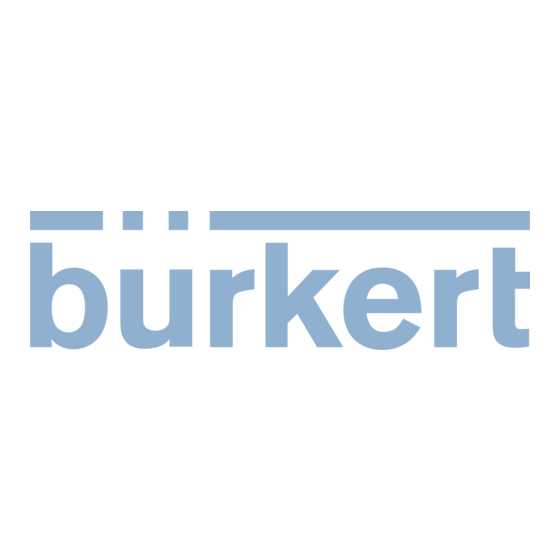

Burkert 2030 Quick Start Manual
Piston-operated diaphragm valves
Hide thumbs
Also See for 2030:
- Operating instructions manual (112 pages) ,
- Quick start manual (45 pages) ,
- Conversion instructions (44 pages)
Table of Contents
Advertisement
Quick Links
Type 2030, 2031, 2032, 2033, 2037
Piston-operated diaphragm valves,
Actuator sizes 40...125, Diameter DN8...DN65
Kolbengesteuerte Membranventile,
Antriebsgröße 40...125 mm, Nennweiten DN8...DN65
Vannes à membrane, commandées par piston,
Tailles d'actionneur 40...125 mm, Diamètre nominale DN8...DN65
Quickstart
English
Deutsch
Français
Advertisement
Table of Contents

Summary of Contents for Burkert 2030
- Page 1 Type 2030, 2031, 2032, 2033, 2037 Piston-operated diaphragm valves, Actuator sizes 40…125, Diameter DN8…DN65 Kolbengesteuerte Membranventile, Antriebsgröße 40…125 mm, Nennweiten DN8…DN65 Vannes à membrane, commandées par piston, Tailles d’actionneur 40…125 mm, Diamètre nominale DN8…DN65 Quickstart English Deutsch Français...
- Page 2 We reserve the right to make technical changes without notice. Technische Änderungen vorbehalten. Sous resérve de modification techniques. © Bürkert Werke GmbH & Co. KG, 2012 - 2024 Operating Instructions 2403/07_EUml_00810102 / Original DE...
-
Page 3: Table Of Contents
Warns of damage! ▶ The Quickstart must be available to each user. Important tips and recommendations. ▶ The liability and warranty for the Type 2030, 2031, 2032, 2033 and 2037 will be invalidated if the Quickstart instructions are not followed. -
Page 4: Intended Use
Type 2030, 2031, 2032, 2033, 2037 Intended use INTENDED USE BASIC SAFETY INSTRUCTIONS This safety information does not take into account any contin- Non-intended use of the device may be dangerous to people, gencies or occurrences that may arise during installation, use and nearby equipment and the environment. - Page 5 Type 2030, 2031, 2032, 2033, 2037 Basic safety instructions ▶ For applications planning and operation of the device, Hot surfaces and fire hazard. observe the plant-specific safety regulations. The plant owner If the device is left on for an extended period of time, its surface is responsible for the safe operation and handling of the can become hot.
-
Page 6: General Notes
Installation position: any, preferably Information online actuator face up. Operating instructions and data sheets for Type 2030, 2031, Tank bottom valve type 2033: 2032, 2033 and 2037 can be found on the Internet at: Actuator face down country.burkert.com... - Page 7 Type 2030, 2031, 2032, 2033, 2037 Technical data Control functions (CF) Labelling of tube valve body (VP) Closed by spring force in rest position Material Company logo Heat Opened by spring force in rest position Actuating function via reciprocal pressurisation 1.4435...
- Page 8 Type 2030, 2031, 2032, 2033, 2037 Technical data Usage conditions Medium temperature for diaphragms: The indicated medium temperatures apply only to media WARNING! which do not corrode or swell the diaphragm materials. Danger of bursting in case of overpressure. The behaviour of the medium with respect to the diaphragm If the device bursts, the medium may cause injuries, burns or may be changed by the medium temperature.
- Page 9 Type 2030, 2031, 2032, 2033, 2037 Technical data Pressure temperature diagram for plastic valve body Pilot pressure for control function A: Permitted medium pressure depending on medium temperature in The values are valid for bodies made from: plastic valve body: •...
-
Page 10: Installation
Type 2030, 2031, 2032, 2033, 2037 Installation INSTALLATION Installation positions The installation positions of the diaphragm valves vary DANGER! depending on the valve body. Danger from high pressure. 7.1.1 Installation position 2/2-way valve ▶ Before loosening lines or valves, switch off the pressure and bleed the lines. - Page 11 Type 2030, 2031, 2032, 2033, 2037 Installation The self-draining angle is specified as a value on forged steel 7.1.2 Installation position T-valve Type 2032 valve bodies (VS) and tube valve bodies (VP) (see chapters Installation for leakage detection “6.5” and “6.6”).
- Page 12 Installation conditions → Ensure that pipelines are in alignment. 7.2.2 Weld or glue the valve body Types 2030, → Support and align pipelines. To ensure that the pipeline is self- 2031, 2032 and 2037 into the pipeline...
- Page 13 Type 2030, 2031, 2032, 2033, 2037 Installation 1. Weld the tank bottom body to the container bottom. Upper pilot air port NOTE (for CFA and CFI) Before welding, note the following: ▶ Only use welding materials which are suitable for the tank Lower pilot air port bottom body.
- Page 14 Type 2030, 2031, 2032, 2033, 2037 Installation → Slightly tighten the body screws crosswise until the dia- Nominal Tightening torques for diaphragms [Nm] phragm rests between the body and the actuator. diameter VS, PP, PVC, PVDF, VG VA and VP Do not tighten the screws yet.
-
Page 15: Maintenance Work
Type 2030, 2031, 2032, 2033, 2037 Maintenance work MAINTENANCE WORK Inspection intervals The following maintenance must be performed on the diaphragm Actuator valve: When used in accordance with these operating instructions, the → After the first steam sterilisation, or when required, retighten actuator of the diaphragm valve is maintenance-free provided it is body screws crosswise. - Page 17 country.burkert.com...













Need help?
Do you have a question about the 2030 and is the answer not in the manual?
Questions and answers